Angular leaf spot of snap beans
Learn about the symptoms, biology, and management strategies for angular leaf spot of snap beans.
Introduction
Angular leaf spot (ALS), caused by the fungus Phaeoisariopsis griseola, is considered a serious disease of beans in many regions. ALS has been recently observed on snap beans growing in Ontario. Up to 80% yield loss was observed in one field of Roma beans severely infected with P. griseola in 2000. This disease has been reported previously in more than 70 countries, including Mexico and the United States. In Brazil the disease was considered a minor nuisance at first but is now one of the most economically important diseases of dry beans. The pathogen can infect common, lima, scarlet runner, tepary, black gram, adzuki beans and cowpea, and has been observed on peas.
Symptoms
All aerial plant parts, including leaves, petioles, stems and pods can be infected (Figure 1), but symptoms are most recognizable on leaves. Lesions on leaves usually appear as brown spots with a tan or silvery centre that are initially confined to tissue between major veins, which gives it an angular appearance (Figure 2). On some varieties a yellow halo occasionally surrounds lesions and eventually the entire leaflet becomes yellow before senescing (Figure 3). Lesions can be observed on the underside of the leaf and appear slightly more pale than those on the upper surface of the leaflet (Figure 4). A close look at lesions on the underside of a leaflet with a magnifying lens will reveal tiny dark tufts (synnemata) protruding from lesions (Figure 5). These dark tufts are a collection of stalks (conidiophores) that produce spores, which are wind-blown or rain-splashed to other healthy tissue. Lesions on stems and petioles appear dark brown and elongated. Lesions on pods are circular, black and sunken (Figure 1), and look similar to anthracnose (Colletotrichum lindemuthianum).
Yield reduction caused by ALS is due mainly to a reduction in photosynthetic area; however, the fungal pathogen can also reduce quality by causing lesions on pods. Yield losses of 10%-50% have been reported in the northern U.S. and up to 80% in tropical and subtropical countries.
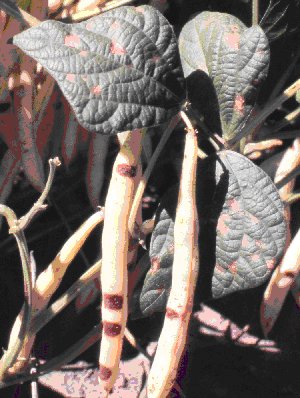
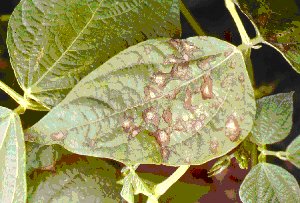
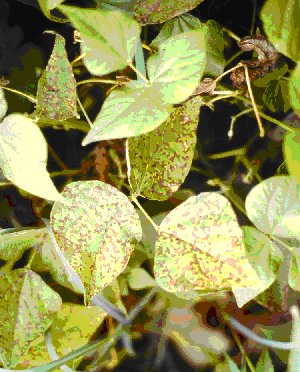
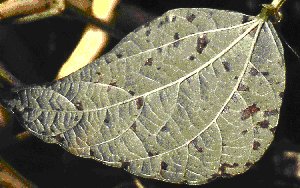
Biology
Studies indicate P. griseola can survive Ontario winters in infested bean residue left on the soil surface (Figure 6); however, the pathogen does not survive very long when infested bean debris is buried in soil and decomposes. The pathogen can also survive between seasons on infested seed, which is one pathway of introduction into fields. Spores from lesions on stems, leaves and pods, as well as on crop debris, only develop after continuous high humidity or wet conditions for 24-48 hours. Spores produced on infested debris or seed are rain-splashed and/or wind-blown onto healthy tissue after planting. When spores land on susceptible bean tissue, they germinate and infect through natural pores (stomata). Disease develops rapidly during periods of warm temperatures (24°C) but can occur over a range of moderate to warm temperatures (16°C-28°C) when accompanied by wet weather or high humidity alternating with dry, windy conditions.
In Ontario, ALS tends to develop and spread quickly during late summer on late seeded snap bean crops when day temperatures are warm and night temperatures become cool resulting in dew formation on plants. However, significant disease development and yield loss can also occur on earlier seeded crops if moderate temperatures coincide with prolonged periods of wet weather.
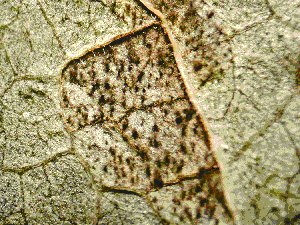
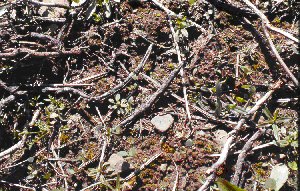
Management
Most snap bean varieties grown in Ontario are susceptible to ALS (Table 1).
- Grow the least susceptible varieties, particularly in fields with a history of ALS, to reduce disease impact on the quantity and quality of yield.
- Rotate crops with non-host crops for at least two years and deep plough infested crop residue. This significantly reduces survival of the fungal pathogen.
- Apply an effective fungicide during early bloom (10%-30% flowering) when environmental conditions are conducive for disease. Consider applying a second fungicide application seven days later at late bloom (50%–70% flowering) if environmental conditions favouring infection and disease development occur between early bloom and late bloom, or are predicted after late bloom.
- Always read and follow the fungicide label before applying a fungicide. Refer to the latest version of OMAFRA Publication 363, Vegetable Production Recommendations, for specific fungicide recommendations.
| Variety | Susceptibility |
|---|---|
| Gold Mine | Highly susceptible |
| Gold Rush | Highly susceptible |
| Strike | Highly susceptible |
| Hialeah | Highly susceptible |
| Green crop | Highly susceptible |
| Euredk | Highly susceptible |
| French Horticulture Bean | Very susceptible |
| Bronco | Very susceptible |
| Cloudburst | Very susceptible |
| Matador | Very susceptible |
| Stallion | Very susceptible |
| Opus | Very susceptible |
| Storm | Susceptible |
| Bush Blue Lake 47 | Susceptible |
| Tema | Susceptible |
| Roma II | Susceptible |
| Brio | Susceptible |
| Grenoble | Susceptible |
| Shade | Susceptible |
| Distinction | Susceptible |
| Carlo | Susceptible |
Footnotes
- footnote[1] Back to paragraph Based on evaluations in field and growth room studies conducted in Ontario.